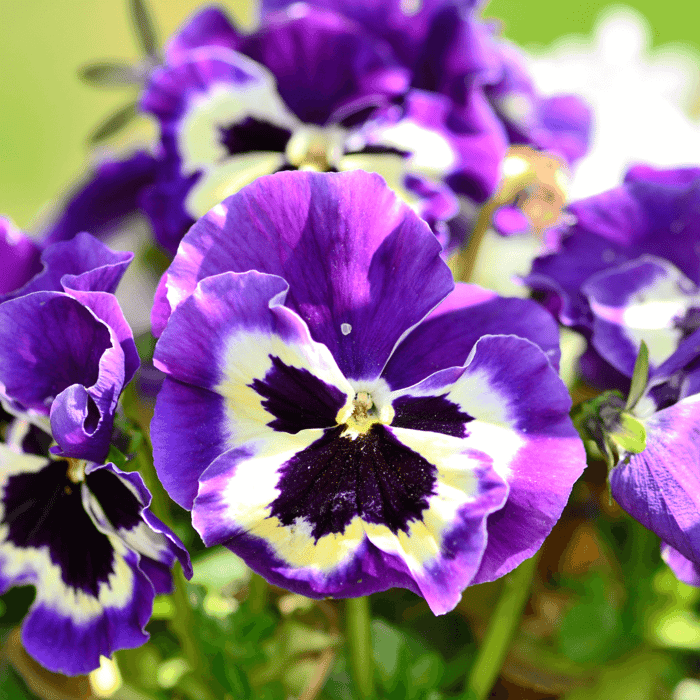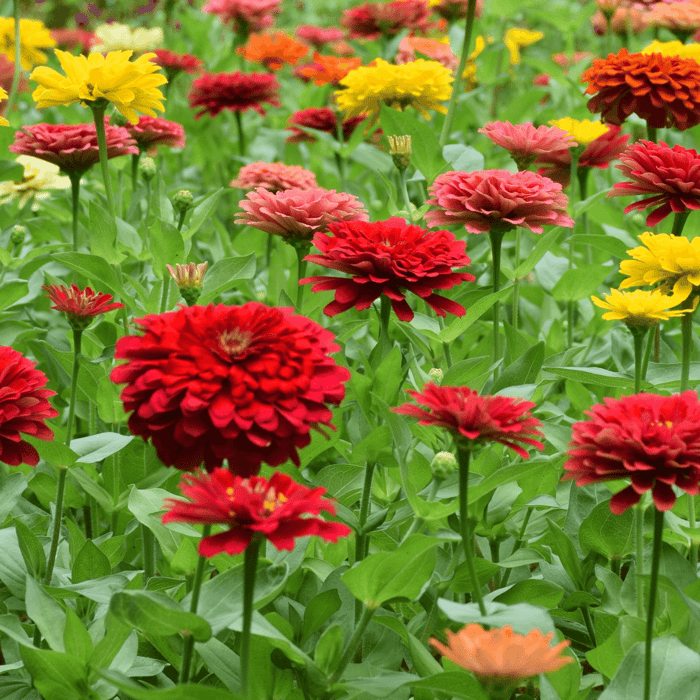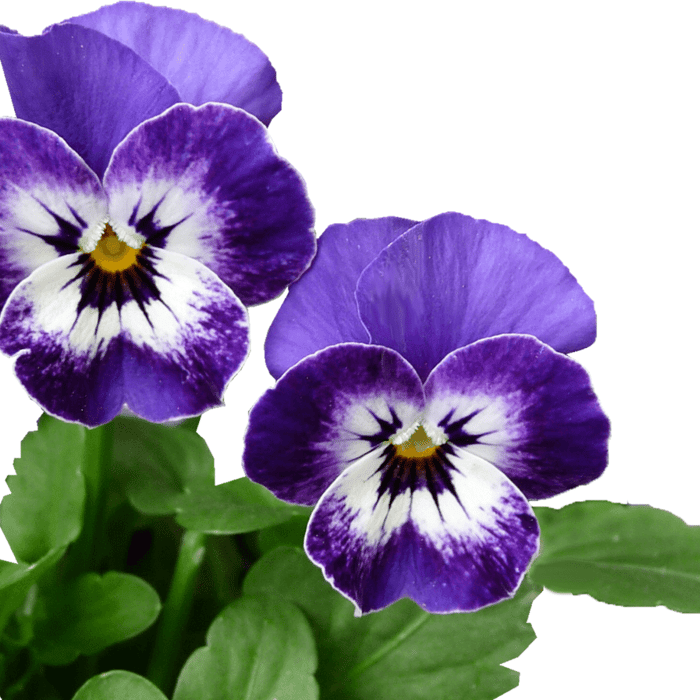As an avid gardener who loves to see her garden filled with vibrant colors, I've found that growing Swiss Giant Pansies from seed is an enriching experience. Pansies are not only easy to grow but also offer a wide variety of stunning colors to brighten up your garden during the cooler months. In this step-by-step guide, I will walk you through everything you need to know about growing Swiss giant pansy from seed.
Table of Contents
- Introduction to Swiss Giant Pansy
- History of the Swiss Giant Pansy Seed
- Plant Characteristics
- Choosing the Right Seeds
- Preparing the Seed-Starting Environment
- Planting and Germination
- Transplanting and Plant Care
- Harvesting and Enjoying Your Pansies
1. Introduction to Swiss Giant Pansy
Swiss Giant Pansies are a popular pansy variety that features large, 3- to 4-inch flowers in many colors, such as blue, purple, yellow, and white. These pansy flowers are perfect for adding a touch of color to your garden during the cool weather of spring and fall. Swiss Giant Pansies thrive in USDA zones 4-8 and can be grown in full sun or partial shade.
2. History of the Swiss Giant Pansy Seed
Swiss Giant Pansies (Viola x wittrockiana) are a hybrid variety developed in Switzerland during the early 20th century. They are known for their large blooms and have been a favorite among gardeners for decades.
Pansy Swiss Giants Mix Seeds
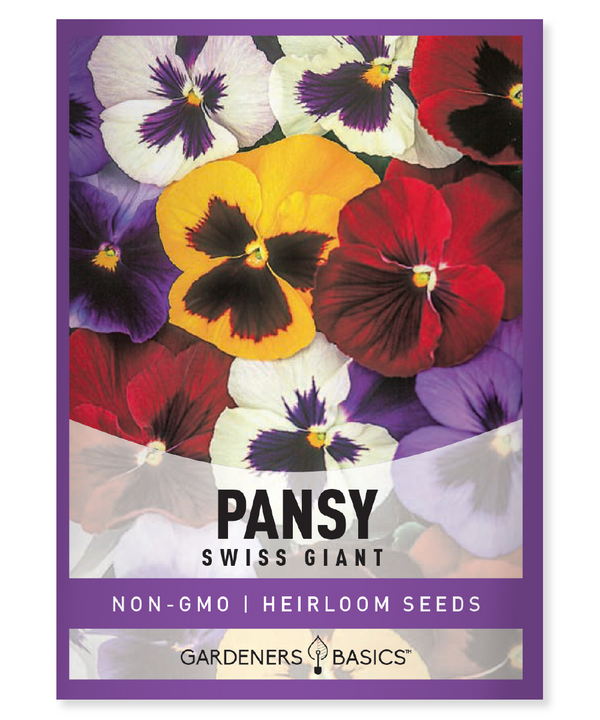
$2.49
Swiss Giant Pansy Seeds - Heirloom, Non-GMO, Non-Hybrid, Open-Pollinated | Vibrant Blooms for Any Garden Elevate your garden with our Swiss Giant Pansy flower seeds, known for their large, vibrant blooms and striking color patterns. These heirloom, non-GMO, non-hybrid, open-pollinated… read more
3. Plant Characteristics
Before we dive into the process of growing Swiss Giant Pansies from seed, let's take a look at their crucial plant characteristics:
- Days till maturity: 60-75 days
- Planting depth: 1/8 inch
- Plant spacing: 6-12 inches apart
- Days to germination: 10-21 days
- Start indoors or direct sown: Both options are viable, but starting seeds indoors is recommended for the best results
- Full sun or partial shade: Both options are suitable, but partial shade is preferred
- When to harvest: Flowers can be harvested when fully bloomed, usually in the spring and fall
- Plant height: 6-9 inches tall
- Plant width: Up to 12 inches wide
4. Choosing the Right Seeds
Select high-quality Swiss Giant Pansy seeds from reputable garden centers or online retailers. Look fornewh sources, as older origins may have a lower germination rate. Remember that pansy seeds are tiny, so be gentle when handling them to avoid damaging them. We would love for you to look at our pansy and flower seeds in our store!
5. Preparing the Seed-Starting Environment
Materials Needed
- Pansy seeds
- Seed-starting mix
- Seedling trays or pots
- Plastic wrap or seedling tray dome
- Heating mat (optional)
Instructions
- Fill your seedling trays or pots with a moistened seed-starting mix, leaving about 1/4 inch of space from the top.
- Place the trays or pots in an area with a consistent temperature of 65-75°F (18-24°C) for optimal germination. If necessary, use a heating mat to maintain the temperature.
- Ensure your seed-starting area is exposed to 12-14 hours of light daily, either from a sunny window or supplemental grow lights.
6. Planting and Germination
- Sow the pansy seeds on the surface of the seed-starting mix, spacing them evenly. Remember, the planting depth should be 1/8 inch, so you can gently press the seeds into the mixture without burying them.
-
Lightly cover the seeds with a thin layer of seed-starting mix or fine vermiculite to maintain moisture and protect them from light.
-
Mist the seeds with water using a spray bottle to ensure they stay moist but are not waterlogged.
-
Cover the seedling trays or pots with plastic wrap or a seedling tray dome to create a humid environment for germinating seeds.
-
Keep the trays or pots in the seed-starting environment, maintaining the appropriate temperature and light conditions. Check daily to ensure the soil remains moist, and mist with water as needed.
-
Swiss Giant Pansy seeds typically germinate within 10-21 days. Once the seedlings have sprouted and developed their first set of true leaves, you can remove the plastic wrap or dome.
7. Transplanting and Plant Care
-
When the seedlings have at least two sets of true leaves, and the outdoor soil temperature is consistently above 45°F (7°C), they can be transplanted outdoors. Before transplanting, gradually acclimate the seedlings to outdoor conditions by placing them outside in a sheltered area for a few hours each day, increasing the duration over a week. This process is known as "hardening off."
-
Choose a planting location with rich, well-drained soil and either full sun or partial shade. Swiss Giant Pansies prefer partial shade, especially in warmer climates.
-
Space the plants 6-12 inches apart, depending on the desired fullness of your pansy bed.
-
Water the transplanted pansies thoroughly, and continue to water regularly, keeping the soil moist but not waterlogged.
-
Apply a balanced, slow-release fertilizer to encourage strong growth and abundant blooms.
-
To promote bushy growth and more colors, pin the plants' growing tips when they are 3-4 inches tall.
-
Regularly deadhead spent flowers to encourage continuous blooming throughout the season.
Wildflower, Perennial, & Annual Flower Seed Kit | 35 Variety Pack
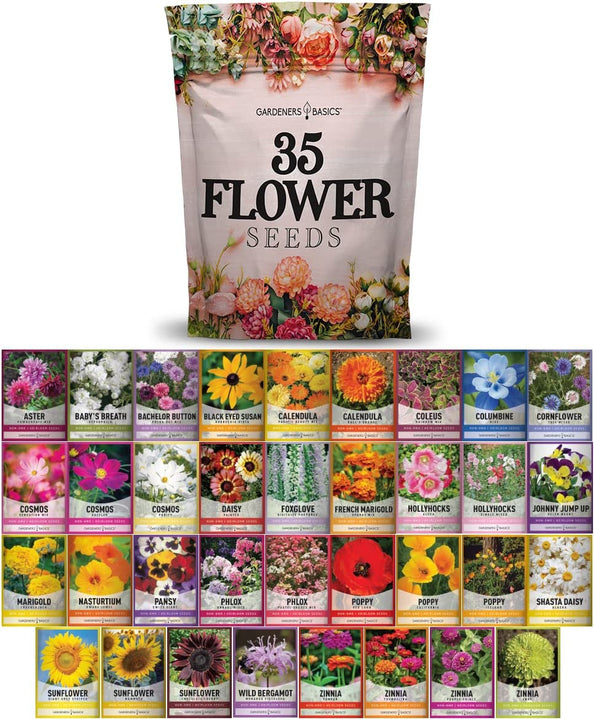
$29.95
$49.95
35 Flower Seeds Variety Pack – Heirloom, Non-Hybrid, Non-GMO, Open-Pollinated – Perfect for Pollinator-Friendly Gardens Transform your garden with our 35 Flower Seeds Variety Pack, offering a stunning and diverse selection of heirloom, non-hybrid, and non-GMO seeds. Each variety in… read more
8. Harvesting and Enjoying Your Pansies
Swiss Giant Pansies are beautiful, and their flowers are edible and can be used as a colorful garnish for salads and desserts. Harvest the flowers when they fully bloom, usually in the spring and fall. Be sure to harvest flowers from plants not treated with pesticides or other chemicals.
In conclusion, growing Swiss Giant Pansies from seed is an enjoyable and rewarding gardening project. Following this step-by-step guide, you can enjoy these stunning, colorful flowers throughout the cooler months of spring and fall, adding a touch of beauty and vibrancy to your garden.
 Frequently Asked Questions - How to Grow Swiss Giant Pansy From Seed
Frequently Asked Questions - How to Grow Swiss Giant Pansy From Seed
Q1. Can Swiss Giant Pansies be grown in containers?
A1. Absolutely! Swiss Giant Pansies adapt well to container gardening. Choose a container with good drainage, and use a high-quality potting mix. Remember to water regularly, as container plants tend to dry out more quickly than those planted in the ground.
Q2. How do I store leftover pansy seeds?
A2. Place leftover pansy seeds in an airtight container or a sealed plastic bag to store leftover pansy seeds. Label the container with the seed variety and the date, then store it in a cool, dry, and dark location. Properly stored pansy seeds can remain viable for up to two years.
Q3. Do Swiss Giant Pansies require special care during winter?
A3. Swiss Giant Pansies may benefit from a layer of mulch to protect their roots from freezing temperatures in colder climates. However, in milder climates, these pansies can often overwinter without special care, providing color in your garden even during the cooler months.
Q4. Are Swiss Giant Pansies deer-resistant?
A4. While no plant is completely deer-resistant, Swiss Giant Pansies are not a preferred food source for deer. They may still be nibbled occasionally, but deer are less likely to cause significant damage to these plants than other garden favorites.
Q5. How can I encourage Swiss Giant Pansies to bloom more?
A5. To encourage more blooms, provide your Swiss Giant Pansies with adequate water, well-drained soil, and balanced, slow-release fertilizer. Additionally, deadheading spent flowers regularly will promote continuous blooming throughout the season.
Q6. Can I grow Swiss Giant Pansies as perennials, or are they annuals?
A6. Swiss Giant Pansies are often treated as annuals or short-lived perennials. They tend to bloom more profusely in their first year, and their performance may decline in subsequent years. However, if provided with the right conditions and proper care, they can be grown as perennials in some regions.
Q7. Do Swiss Giant Pansies attract pollinators?
A7. Swiss Giant Pansies can attract pollinators like bees and butterflies to your garden. While they may not be the primary choice for pollinators, their colorful blooms can still provide an important nectar source during the cooler months of spring and fall when other flowers are scarce.
Q8. Are Swiss Giant Pansies susceptible to any pests or diseases?
A8. Swiss Giant Pansies can be affected by pests such as aphids, slugs, and snails, as well as diseases like powdery mildew and pansy leaf spot. To minimize these issues, maintain proper watering practices, ensure good air circulation around the plants, and promptly remove any dead or diseased plant material.
Q9. Can I grow Swiss Giant Pansies from cuttings?
A9. While it is possible to propagate Swiss Giant Pansies from cuttings, growing them from seeds is generally easier and more reliable. Propagating from cuttings may not result in plants that are true to the parent plant's characteristics, and the success rate can be lower than growing from seeds.
Q10. What companion plants work well with Swiss Giant Pansies?
A10. Swiss Giant Pansies make excellent companions for other cool-season flowers and foliage plants. Some good companion plants include spring bulbs like tulips and daffodils, primroses, violas, snapdragons, and ornamental kale. These plants complement your Swiss Giant Pansies and create a stunning cool-weather garden display.



